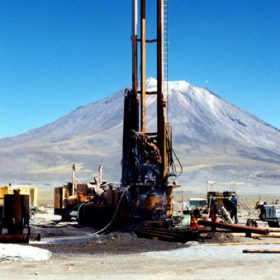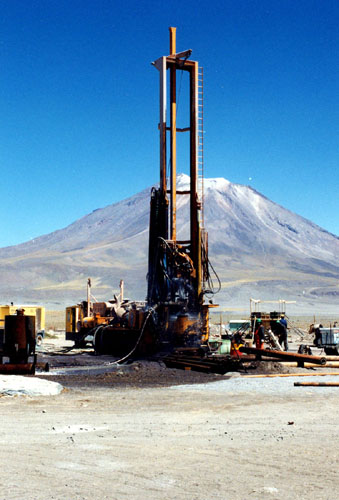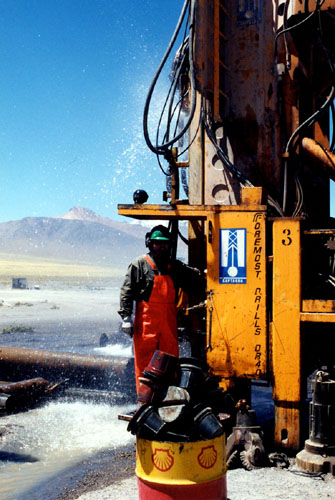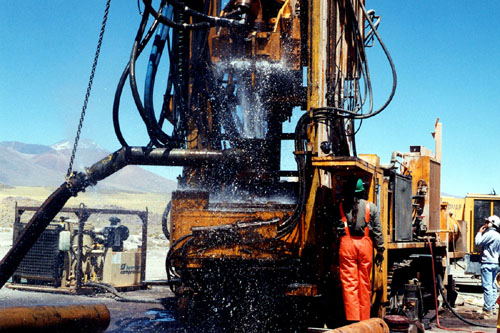
| Application | Water Well Drilling |
|---|---|
| Location | Ojos De San Pedro, Chile |
| Hammer | Challenger™ 125 |
| Bit | Conventional |
| Hole Size | 23 - 17 inches (584 - 432 mm) |
| Depth or Length | 818 feet (250 m) |
| Formation | Volcanic, Basalt |
| Rig Type | Foremost DR24 |
Description
 High in the mountains 75 miles (120 km) northeast of Calama, Chile there are five volcanoes that have shaped the landscape of the area for centuries. Through years of activity, these volcanoes have created ground formations of volcanic rock and basalt that have combined with the already difficult mountainous terrain. The combination of the demanding formations coupled with high altitude and varied temperatures from 5° F to 59° F (-15° C to 15° C) have significantly hampered drilling operations in the area. That is, until now.
High in the mountains 75 miles (120 km) northeast of Calama, Chile there are five volcanoes that have shaped the landscape of the area for centuries. Through years of activity, these volcanoes have created ground formations of volcanic rock and basalt that have combined with the already difficult mountainous terrain. The combination of the demanding formations coupled with high altitude and varied temperatures from 5° F to 59° F (-15° C to 15° C) have significantly hampered drilling operations in the area. That is, until now.
 A recent drilling project in this region required drilling contractor, Ingeneria Captagua to install seven (7) water wells to provide sufficient water supply for the mine of Chuquicamata to a maximum depth of 818 feet (250 meters). The drilling conditions were extremely difficult with an altitude of 14,000 feet (4,270 m) and temperatures ranging between 32° F and 50° F (0° C and 10° C). An additional complication was that it was required that each well be drilled down to 818 feet (250 meters) no matter how much water was encountered at the top of the hole. Relying on their experience in the area, Ingeneria Captagua knew traditional drilling methods would not work in this environment and that they needed to find the right drilling technology to conquer this task. They turned to their Chilean drilling products distributor, Thiessen SA, to help provide the right tools.
A recent drilling project in this region required drilling contractor, Ingeneria Captagua to install seven (7) water wells to provide sufficient water supply for the mine of Chuquicamata to a maximum depth of 818 feet (250 meters). The drilling conditions were extremely difficult with an altitude of 14,000 feet (4,270 m) and temperatures ranging between 32° F and 50° F (0° C and 10° C). An additional complication was that it was required that each well be drilled down to 818 feet (250 meters) no matter how much water was encountered at the top of the hole. Relying on their experience in the area, Ingeneria Captagua knew traditional drilling methods would not work in this environment and that they needed to find the right drilling technology to conquer this task. They turned to their Chilean drilling products distributor, Thiessen SA, to help provide the right tools.
Thiessen SA recommended using Numa DTH hammers and bits for the project as they provided the fastest and most reliable performance in the industry. The Challenger 125 hammer (N125) was chosen as it provided the appropriate range for the various bit sizes to be used. Additionally, the N125 hammer has a reputation in the drilling industry for being able to handle high volumes of water or high back pressure and continue to drill down to the target depth long after other hammers have quit. Designed for long life and fast penetration rates in hard rock conditions, the Challenger 125 hammer is perfectly suited for completing rock sockets, caissons, foundation holes, elevator shafts, exploration drilling, blast hole drilling, water wells or any other rock drilling project.
 The installation of this water well required that a series of holes be drilled by telescopic method ranging from 23″ to 17″ (584 – 432 mm) in diameter to a final depth of 800 feet (250 m). Much of this drilling was conducted in volcanic rock and basalt but also against water in the hole. Static water was found 60 feet (18 m) down and remained throughout the drilling. The wells were measured to produce over 3600 gallons (14,400 liters) per minute of water. Baroid drilling foam was used to help get the water and drill cuttings out of the hole.
The installation of this water well required that a series of holes be drilled by telescopic method ranging from 23″ to 17″ (584 – 432 mm) in diameter to a final depth of 800 feet (250 m). Much of this drilling was conducted in volcanic rock and basalt but also against water in the hole. Static water was found 60 feet (18 m) down and remained throughout the drilling. The wells were measured to produce over 3600 gallons (14,400 liters) per minute of water. Baroid drilling foam was used to help get the water and drill cuttings out of the hole.
A key factor for this project was that the drilling had to be done at an extremely high altitude. High altitude and high temperatures have a direct effect on the molecular structure of air. These factors must be kept in mind when analyzing how much air a hammer will need for a job. An adjustment in CFM (l/sec) must be made to accommodate such changes to provide for fast and efficient drilling. At high altitudes, there are fewer molecules in a given volume of air than at lower altitudes. Therefore when a compressor displaces a given volume at high altitudes, the air will be less dense and require more volume than at sea level. To calculate the appropriate volume of air required for drilling conditions, we recommend using a CFM correction factor chart.
 In the mountains of Ojos De San Pedro, Ingeneria Captagua drilled at 14,000 feet (4,270 m) above sea level with an average temperature of approximately 40 F (4° C). At sea level, Numa’s Challenger 125 requires only 1800 CFM (850 L/SEC) at 200 PSI (13.7 BAR). By using a correction factor chart, they were able to calculate a need of 2850 CFM (1345 L/SEC). When drilling began with the Foremost DR24 rig, Ingeneria Captagua had linked together the rig’s Sullair 950/350 compressor with two Atlas Copco 950/350 compressors to provide the correct volume of air. If they had used only the standard requirement of 1800 CFM (L/SEC) and not used a CFM correction factor chart, their actual air volume would have been only 1102 CFM, which would not have been enough to properly operate the hammer and lift the cuttings out of the hole.
In the mountains of Ojos De San Pedro, Ingeneria Captagua drilled at 14,000 feet (4,270 m) above sea level with an average temperature of approximately 40 F (4° C). At sea level, Numa’s Challenger 125 requires only 1800 CFM (850 L/SEC) at 200 PSI (13.7 BAR). By using a correction factor chart, they were able to calculate a need of 2850 CFM (1345 L/SEC). When drilling began with the Foremost DR24 rig, Ingeneria Captagua had linked together the rig’s Sullair 950/350 compressor with two Atlas Copco 950/350 compressors to provide the correct volume of air. If they had used only the standard requirement of 1800 CFM (L/SEC) and not used a CFM correction factor chart, their actual air volume would have been only 1102 CFM, which would not have been enough to properly operate the hammer and lift the cuttings out of the hole.
At the completion of the project, it was clear to Ingeneria Captagua, Thiessen SA and Numa that Numa’s Challenger 125 hammer and bits were the right choice for this demanding drilling job. The DTH products performed flawlessly in the hard formations, high altitude and varied temperatures to successfully install the seven (7) wells with no down time due to product failure. To attain these results, the most critical factor was calculating the CFM required by Ingeneria Captagua’s drilling environment to insure that the hammer performed to its usual high standards. It is this teamwork approach that allows companies like Ingeneria Captagua to continue to be at the forefront of the drilling industry.
Get to the bottom of it with Numa.

